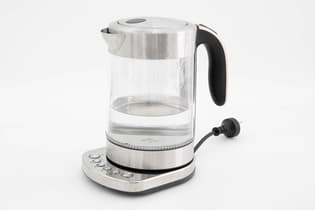How to make your kettle quieter
A quick clean is proven to make your kettle quieter.

Want a cuppa, but sick of trying to lip-read your favourite show while the kettle boils?
Keeping your kettle clean will help maintain performance, lengthen its lifespan and reduce the volume of boiling. The best part – no special products are required. You’ll likely have everything you need already at home.
Why are kettles SO loud?
Ever wondered what those chalky marks are on the inside of your kettle? That’s limescale. Limescale is caused by a build-up of calcium and magnesium in hard water. Leaving water sitting in your kettle encourages limescale to develop.
When you heat water, it evaporates. But the remaining liquid is super-concentrated with minerals such as calcium and magnesium. And so in hard-to-reach places like the bottom of an electric kettle, a build-up of limescale develops.
While not harmful, it can add an undesirable metallic taste to water, not to mention making boiling louder!

That annoying thumping, knocking noise of a kettle boiling is the sound of collapsing bubbles of steam. Water doesn’t heat up evenly – little bubbles of hot water expand from the bottom of the kettle. As the bubbles rise and cool, they suddenly (and noisily) collapse. That process is called cavitation. Kettles are noisiest when they first start to boil and the hot bubbles have to move through very cold water, so collapse faster.
Limescale is an insulator. Allowing it to build up slows down the transfer of heat, so the kettle takes longer to boil and is noisier while it boils.
There are ‘quiet’ kettles available which claim to produce about 50dB. However, they still develop limescale, which over time will increase the volume. No kettle is immune.
Our test results
We used a sound level meter to record the volume of a kettle with limescale build-up, boiling before and after being cleaned.
The sound reduced from 79.1dB to 75.4dB. It doesn’t seem like much, but as the dB scale is logarithmic, a small difference in dB is a big change to what you hear. A 5dB drop is actually about 25% quieter – which could be the difference between lip-reading the TV and hearing it.
The decibel scale

Here’s how to make your kettle quieter
Step 1 – Fill the kettle just under halfway with equal parts white vinegar and water. Be careful not to overfill as the mixture will bubble up. Lemon juice works too; swap with the vinegar if preferred.
Step 2 – Swirl to mix the vinegar and water. Let sit for one hour.
Step 3 – Boil.
Step 4 – Allow it to cool.
Step 5 – Rinse and refill with water. Repeat this step until the smell of vinegar has gone.
Step 6 – Enjoy your quiet kettle!
Bonus tip
You may have noticed limescale on your showerhead too. Yes, you can use the same solution to remove it here. Fill a plastic bag or wet a towel in the solution and tie it around the shower head, making sure the surface with limescale is in contact with the solution. Leave it for one hour then rinse off. Limescale gone.

Subscribe to our newsletters
Get even more Consumer NZ news and invitations to share your voice on important issues straight to your inbox. You don’t have to be a member to have these newsletters emailed to you regularly.
We've tested 43 jugs and kettles.
Find the right one for you.

.jpg&w=315&q=75)

Member comments
Get access to comment